Monday 28 January 2013
The Maori Wrasse - A Colorful, Inquisitive Tropical Fish
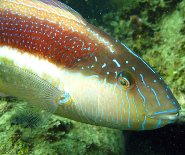
The
Maori wrasse (
Ophthalmolepis lineolata) is an oceanic fish that inhabits the coral reefs, rocky coasts and sandy, weedy bays off eastern and southern Australia. It also thrives in New Zealand waters, notably in Nelson Bay. The Maori wrasse is noted for its striking colors and "friendliness" toward humans, which some believe could lead to ecological complications.
Colors change with age. Females and young fish are reddish-orange or crimson, fading in color intensity on the underside. Males, which are larger, feature side stripes and blue markings about the body and head. These markings remind of the tattoos common among the Maori culture of New Zealand, hence the name.
More than 400 species of wrasses have been identified in the world's oceans. Most swim tropical and temperate waters. They generally prefer relatively shallow coral and rocky environs, although in cooler waters, Maori wrasses may be found at depths of 60 meters (197 feet).
The fish grow as long as 47 centimeters (18 inches) and weigh as much as .9 kilograms (2 pounds). They are not at all skittish. Divers easily can approach closely and take pictures. In fact, Maori wrasses often follow swimmers and divers through the water. It has been suggested Maori wrasses are as curious about humans as humans are about them.
The classification "Maori wrasse" has been applied to numerous fish, and
Ophthalmolepis lineolata has been confused with similar species. For example, the
Humphead wrasse (
Cheilinus undulatus) also has been dubbed "Maori wrasse." The Humphead is the largest species in the wrasse group.
Ophthalmolepis lineolata may be distinguished as the "southern" Maori wrasse. It has been called the Maori parrotfish, Australian Maori wrasse, Rainbow-fish and simply Maori - but some of those names, too, have been confused.
Wrasses have sharp front teeth and crushing molars along the throat, employed to fragment prey. Wrasses eat mollusks, crustaceans and other invertebrates of different sizes. The Maori wrasse feeds on benthic (ocean floor) invertebrates. Wrasses are the victims, in turn, of larger predator fish such as sharks, barracudas and eels.
Maori wrasses regularly are brought up as a by-catch by coastal net fishers. In some areas, regulations prohibit commercial use; regulations vary by wrasse species. The Maori wrasse is used a bait fish and is exported as an aquarium fish. Certain other species of wrasses are considered edible delicacies.
While not endangered presently, Maori wrasses face long-term threats resulting from reef deterioration.
Picture of the Maori wrasse by Richard Ling from NSW, Australia, licensed under the
Creative Commons Attribution-Share Alike 2.0 Generic license.
You can help spreading the word about this animal by liking it on facebook
Permanent Link
Tuesday 22 January 2013
Chilean guemal - Chile's endangered national symbol
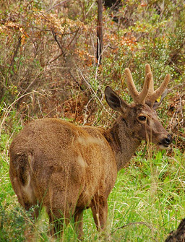
The
Chilean guemal (
Hippocamelus bisulcus) is a highly endangered species of deer found in the high, frigid mountains of Chile and Argentina. They are also sometimes called the Chilean huemul, South Andean huemul, Patagonia huemul and taruca. With compact bodies and short legs, this species is well-adapted to surviving in the rugged and difficult terrains of the Andes mountains. They have long been a symbol of Chile and are depicted on its national coat-of-arms.
As with most species of deer, the Chilean guemal is distinguished with a short tail and thick coat of hair. Their hide is brown to grayish-brown across the back and sides, tapering to white on the undersides and along the throat. They are known for their very thick, curly hairs which help protect them in weather that is often well below zero. Their average weight and height ranges from 70 kg. (154 lbs.) and 80 cm. (31 in.) for does to 90 kg. (198 lbs.) and 90 cm. (35 in.) for bucks. Only the bucks have antlers, which they shed each year at the end of winter. Bucks also have a distinctive black face mask which is shaped like an elongated heart. All fawns are born without spots.
Although they were once very common in the mountainous regions of lower, southwestern South America, the populations of Chilean guemal are now found only in Chile and very limited parts of Argentina. They prefer to live in herds consisting of both males and females. Most of their time during the summer months is spent in very high and rugged mountain cliffs while in winter they prefer the lower, forested valleys. Their diets consist mainly of plants and shrubs such as lichens, grasses and leaves.
The status of the Chilean guemal is now ranked as extremely endangered. Although the
cougar is its only major natural predator, many other factors have caused a rapid decline in the species populations over the past two decades. These factors include hunting by local humans for meat, fire and erosion destruction of native habitats, disease transmitted by livestock and competition for food arising from the growing populations of non-native
Red Deer (
Cervus elaphus). At this time, the remaining populations are found only in the Aysen Region of Chile and in a very small section of adjacent Argentina where their numbers are estimated to be as low as 350 surviving individuals.
Picture of the Chilean guemal by
magical-world, licensed under the
Creative Commons Attribution-Share Alike 2.0 Generic license.
You can help spreading the word about this animal by liking it on facebook
Permanent Link
Monday 21 January 2013
Barbary Macaque - Tailless pickpocket
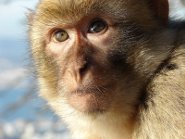
The
Barbary macaque (
Macaca sylvanus) is a monkey species that primarily inhabits the mountainous regions of Algeria and Morocco. After a small population was introduced into the British territory of Gibraltar, this species also became known as the Barbary Ape. However, this is misleading because the Barbary macaque is a true monkey and not an ape. The populations of these monkeys in Gibraltar are the only
primate species, besides humans, to live freely in Europe.
As opposed to most species of monkeys, the Barbary macaque has only a stub for a tail. Their fur is brownish-gray across the backs and outer limbs with undersides that are lighter in color. They are medium-sized and heavy built with front limbs that are longer then the rear limbs. Their maximum size is 75 cm (30 in) and they can weigh as much as 13 kg (29 lb). One of their distinguishing features is the almost human-like agility of the front hands, which the population in Gibraltar uses for adeptly picking the pockets of tourists. They walk on all four limbs, but will occasionally rise on their hind limbs to monitor for threats.
Although they were once common throughout all of North Africa and southern Europe, the primary populations of Barbary macaques are now only found in the high plains and mountains of Algeria and Morocco. They are gregarious in nature, forming groups of both males and females consisting of 10 to 30 individuals. They prefer dwelling in forests of cedar, pine and oak and are equally comfortable on the ground or in trees. Their main activities occur during daylight hours when they range throughout large territories feeding upon leaves, fruits, roots, seeds and insects. The structure of their groups is highly social and unique in that the males participate equally with females in the raising of their young.
Due to their relatively large size as adults and their tight social structure, the Barbary macaque has very few natural predators. Their only major threat is from eagles who will prey upon the young. Unfortunately, the species is listed as endangered due to deforestation of their territories and their systematic extermination by local African farmers who view them as pests. Although they are protected in Gibraltar, the population there is usually kept to less than 250 individuals because of their tendency to cause extensive destruction to human properties and harass tourists for food and trinkets.
Picture of the barbary macaque by
RedCoat, licensed under the
Creative Commons Attribution-Share Alike 2.5 Generic license.
You can help spreading the word about this animal by liking it on facebook
Permanent Link
Thursday 17 January 2013
The Chimney Swift - A City-Dwelling, Flying Cigar
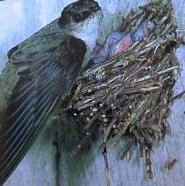
For most animals, the expansion of human civilization is a bad thing. Marshes get drained, forests get cut down, and varmints get exterminated. The
chimney swift (
Chaetura pelagica), is one of the rare few that actually benefit from city living. It commonly nests in chimneys, so cities make for a prime habitat. Before its habitat had lots of buildings and cities, chimney swifts probably nested mainly in caves or hollow trees. Once North America was colonized by Europeans, they had unlimited, convenient chimneys in which to nest. Today, chimney swift populations may actually be declining as a result of newer, closed chimney designs, but it is still designated as "least concern" by the IUCN.
Chimney swifts are often called flying cigars because of the bird's in-flight appearance. Its cylindrical body resembles a cigar with long, slender wings curving backwards. Coloration is almost always a sooty gray or brown with paler feathers on the underside. The tail is short and square. The chimney swift is a small bird of the Apodidea family, which includes all true swifts and is similar, although not closely related, to the swallows. Most swifts are under 10 inches in length, and the chimney swift is small even for a swift.
Size - 5 to 5.5 inches, or 12 to 14 cm.
Weight - rarely more than an ounce. It can range from 14 to 30 grams on average.
Swifts are some of the most aerial birds in the world; they are rarely seen on trees or other perches. Chimney swifts prefer to use their long claws to roost on vertical surfaces, where they build nests out of twigs and attach them with saliva. They are in flight almost constantly, eating, drinking and even bathing in the air. They feed almost exclusively on flying insects caught in mid-air. Even when they need water, chimney swifts usually just swoop down to the surface and bounce right off without stopping.
These birds are found in and around cities throughout the eastern portion of North America. They're migratory, though, so U.S. residents will only see them in spring and summer. They spend the colder months in eastern Peru and other parts of the Amazon. Chimney swifts are much too small to be eaten by humans, but other predators fare a bit better. Swifts are most commonly eaten by hawks, kites and other raptors. While terrestrial predators don't often get the chance to catch an adult chimney swift, nests are sometimes raided by rat snakes and other opportunistic, tree-climbing hunters.
You can help spreading the word about this animal by liking it on facebook
Permanent Link
Wednesday 16 January 2013
The Western Tarsier - the Jungle's Enormous Eyed Leaping Mammal
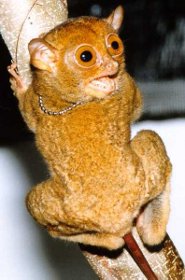
The
Western Tarsier (
Tarsius bancanus), is a tiny mammal found on the islands of Borneo and Sumatra amongst the jungles and rainforests in densely vegetated regions. The tarsier pelage colorings range from sandy beige to dark brown. This mammal is approximately 80 to 160mm (3.15 to 6.3in) long and weighs in at approximately 85 to 160g (3 to 5.8oz). Although this animal is small in size it has extremely large eyes, which are approximately 15mm in diameter. Their eyes are one of the key traits that enable the Western tarsier to be successful during nocturnal hunting. In addition to the large eyes, the Western tarsier also has extremely sensitive ears, similar to a bat, and a heightened sense of smell when hunting. They are equipped with a long tail and elongated hands that aid the tarsiers when hunting prey and moving about in the forest canopy. Tarsiers are mainly insectivorous animals, but also eat lizards, crustaceans, scorpions, snakes and
bats. The tarsiers are typically the prey of
owls.
Tarsiers are only protected by law in Malaysia and Indonesia. They are hunted by people for pets, but soon die as they require live food and are very susceptible to tapeworms. In addition, the destruction of their forest habitat is also reducing the population of the Western tarsiers. The Western tarsier is not currently on the endangered species list, unlike the Philippine tarsier (Tarsius syrichta).
Tarsiers display a variety of interesting behaviors. One unique behavior is the tiny animal’s ability to leap
over 2 meters in distance and 1.5 meters in height. Tarsiers have this ability due to their extremely long hind leg structure as well as using the long tail for balance during the leap.
The tarsiers prefer to groom themselves, except during mating season. This is done using the third and fourth toe claws to scratch their bodies followed by fur licking. The animals clean their faces by rubbing it against tree branches.
They are monogamous and live in family units. This unit consists of the mated pair and offspring. After sexual maturity offspring remain in close proximately to their parents and are sexually mature at one year old. They give birth to one offspring with a gestation period of six months. The offspring are born precocial, with their eyes open and bodies covered with fur. After approximately 45 days, young are weaned as they can capture their own prey.
Picture odf the western tarsier by
Tabdulla, licensed under
GFDL
You can help spreading the word about this animal by liking it on facebook
Permanent Link
Thursday 10 January 2013
The Dzhungarian Hamster - Small animal, big appetite
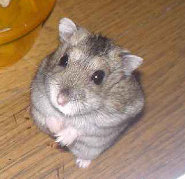
The
Dzhungarian hamster (Phodopus sungorus) is a dwarf rodent with similar characteristic to the larger breeds. These hamsters, which are easy to tame and make good pets for children, come in a variety of colors from gray to a pinkish white. Due to domestication, they can now be found in at least three additional colors - albino, opal, and argent.
Characteristics
Dzhungarian hamster adults are known for having a characteristic darkened stripe of fur that runs from head to tail, and being covered with thick fur throughout. Their bodies are rounded with wide, short legs and sharp claws and teeth. They have black eyes, long whiskers, and fairly short tails. Fur becomes lighter during winter months. Other defining traits include their solitary behavior and burrowing abilities.
Behavior
Dzhungarian hamsters are solitary animals by nature, only meeting for breeding purposes. They live in underground burrows and bring in grass, feathers, or other soft findings to nest in. As for their diet, these hamsters eat grains such as barley and wheat, seeds, legumes, chickpeas, and some plants, which they store in huge cheek pouches while foraging, then store in their burrows. This food management is very useful, especially during the long winter months when they enter a state of hibernation, only waking on warmer days to eat. This hamster has few predators except owls and smalls cats such as the
Snow Leopard.
While these rodents may be considered pests to agriculture in their native homelands of Russia, Siberia, Kazakhstan, and other semi-arid regions, they are welcome in many homes as pets.
Although their maximum life span is only 4 years, females are able to produce up to four litters every year, with each litter size between 5 and 12 pups who each become sexually mature within two to three months. Gestation periods are between 18 and 22 days, with 40 days in between. Pups are born hairless and blind. Their maturity rate and large litter sizes give their breed a strong survival rate. The hamster's conservation status is listed as Least Concern, meaning they are in no danger of extinction.
Weight and Size Measurements
At birth, the Dzhungarian hamsters weight about 2 g (0.07 oz). Fully grown adults weight an average of 23.40 g (0.82 oz).
Head and body length can be between 7 and 10.5 cm (2.76 to 4.13 inches). Tail length is 0.6 to 1.8 cm (.25 to .75 inches).
Picture of the Dzhungarian hamster licensed under
GFDL
You can help spreading the word about this animal by liking it on facebook
Permanent Link
Tuesday 08 January 2013
King Colobus - White-Whiskered African Monkey
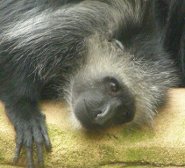
The
king colubus (
Colobus polykomos), which is referred to also as the Western black and white colobus, is an arboreal monkey who is indigenous to central and western Africa, including countries such as Nigeria, Liberia, Togo, GuineaBissau, and Ghana. The monkey is an Old World monkey which is primarily found within the lowlands and the subtropical rainforests.
The animal is fairly small, being between 45 and 72 centimeters or 17.7 and 28 inches in length. The monkey grows significantly between infancy and adulthood with the birth weight of the monkey being approximately 0.709 kilograms or 1.56 pounds. The adult weight of the monkey is far more, being about 9.525 kilograms or 20.955 pounds.
The gestation period of the monkey is about 185 days with female maturity being reached in 1642 days and male maturity being reached at 730 days. The female king colobus has one litter each year with one baby being the result of each gestation period. The interval between litters is typically about 442 days. The maximum longevity of the animal has been reported to be 34 years.
The King colobus eats primarily leaves but has also been known to snack on flowers and fruits as well. Despite the fact that the animal is arboreal, it does not feed in the trees but obtains the majority of its food from the ground in its habitat. The animal usually lives within small groups that consist of between 1 and 3 males and 3 and 4 females, not including the young animals. Each of the groups live fairly far from other groups with territories being defined through territorial calls that are called in order to designate a particular area.
There are no well known predators of the King colobus but, due to its location, it is believed that
leopards, raptors, as well as large snakes could be a potential threat to the black and white monkey. The animal is distinguished from the other species in the colobus genus by their white markings which are present on its chest, tail, and whiskers. Additionally, unlike other species of monkeys, the animal also has reduced thumbs and silky fur.
The King colobus monkey has been identified as an NT or Near Threatened species. This means that they are close to being labeled as a threatened species category sometime in the not so distant future. Therefore, special care must be taken in order to preserve the species.
Picture of the king colubus by Frank Wouters (
Flickr stream), licensed under
Creative Commons Attribution 2.0 Generic license.
You can help spreading the word about this animal by liking it on facebook
Permanent Link
Friday 04 January 2013
The Southern Elephant Seal-A Face Only a Mother Could Love!
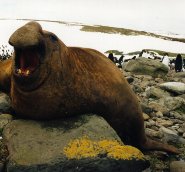
The
Southern elephant seal (
Mirounga leonina) has the unfortunate distinction of being the fattest mammal in the carnivore family. But with an average size of 880 to 1,980 pounds (400 to 900 kg), nobody is making fun of this strange-looking animal, at least not to its odd face. And that’s the smaller of the species; the males typically weigh approximately 4,847-8,800 pounds (2,200 to 4,000 kg.) Stretched out, the Southern elephant seal averages 8 to 16.5 feet long (2.6 m to 5 m.) But its size is not the reason for his name. It’s that big elephant-like proboscis hanging off its face that earned it that moniker.
They are born cute and fuzzy, however, with a thick black fur to keep them warm and cozy. The pups, when fully weaned, spend their days hanging out in a type of “nursery” with other pups until their fur diminishes and they are on their way to adulthood. During that time, they enter the water and learn to swim, never venturing too far from the other seal pups until it’s ready to face life alone. Southern elephant seals live in groups while on land, but hunt individually. It takes the prize for its ability to dive deeper, longer and faster than other species of seals, surpassing even whales and dolphins with its ability to stay under water for long periods and dive to depths of 5,000 feet.
This strange and unusual animal makes its home in several geographical locations. It has been known to come ashore in Antarctica but their true home is in the Southern hemisphere where it hunts in the waters of the Falkland Islands, Argentina and the Indian Ocean. Colonies are also found in the islands of the Pacific Ocean south of New Zealand and Tasmania. But the largest concentration of Southern elephant seals, over half of the entire population, is found in South Georgia. Their habitat, when not in the ocean, is the rocky and sandy beaches where it mates and gives birth.
The Southern elephant seal has few predators. The
orca and the
great white shark, in addition to humans, are its only enemies. Hunted nearly to extinction in the early 1900s, the population is now relatively stable due to strict hunting regulations. It is somewhat threatened, however, as it competes with commercial fishing and other animals for the fish and squid on which they prey.
Picture of the southern elephant seal by B.navez, licensed under
GFDL
You can help spreading the word about this animal by liking it on facebook
Permanent Link
Wednesday 02 January 2013
Ground Pangolin - A Reason to Roll
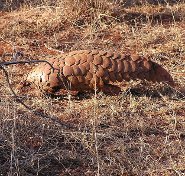
The
Ground Pangolin, Temminck's Pangolin or Cape Pangolin (
Manis Temminckii) is one of four species of pangolin found in Africa. It is the only one of the four which can also be found in southern and eastern Africa. It was named for Coenraad Jacob Temminck a Dutch Zoologist who studied these creatures.
The Ground Pangolin is listed on the United States Fish and Wildlife Services endangered species because this beautiful animal was once hunted for its scales which were used in love potions. It has also been burnt in many brush fires which has added to its endangerment.
The Ground Pangolin is covered almost all over with hard scales except for its soft underside. The scales are colored from grayish brown to dark olive brown. When this animal feels threatened, it will roll up into a ball, hence the title a reason to roll. It could also use its scales on the tail as a slashing tool to ward off potential attackers. Although it is found over a large area of Africa, it is difficult to find because of the threats posed by humans.
It can grow to a length of approximately 1 meter or 3.28 feet. When viewing the body of this animal, it will look very disproportionate, with a small head, small forelegs, large powerful hind legs and a tail which can measure 30 to 50 cm. or 1 to 2 feet approximately.
The Ground Pangolin, like all the
other pangolins, are nocturnal creatures, preferring the nighttime hours. Their diet consists mainly of ants and termites. Their long, sticky tongue makes obtaining these treats easy. The tongue is stored in a pocket in the mouth. Even though they are perfectly capable of digging their own burrows, they usually will occupy unused holes which were previously dug by either warthogs or aardvarks. They can also be found sleeping in dense vegetation which makes finding them even more difficult.
Although their bodies look cumbersome, the Ground Pangolin can move quite rapidly. They have been observed moving at speeds of up to 50 meters or 160 feet per minute. They do move slowly most of the time though and they walk on their hind legs. Their tail is used for balance when they walk.
You can help spreading the word about this animal by liking it on facebook
Permanent Link
 The Maori wrasse (Ophthalmolepis lineolata) is an oceanic fish that inhabits the coral reefs, rocky coasts and sandy, weedy bays off eastern and southern Australia. It also thrives in New Zealand waters, notably in Nelson Bay. The Maori wrasse is noted for its striking colors and "friendliness" toward humans, which some believe could lead to ecological complications.
The Maori wrasse (Ophthalmolepis lineolata) is an oceanic fish that inhabits the coral reefs, rocky coasts and sandy, weedy bays off eastern and southern Australia. It also thrives in New Zealand waters, notably in Nelson Bay. The Maori wrasse is noted for its striking colors and "friendliness" toward humans, which some believe could lead to ecological complications.
 The
The  The
The  For most animals, the expansion of human civilization is a bad thing. Marshes get drained, forests get cut down, and varmints get exterminated. The
For most animals, the expansion of human civilization is a bad thing. Marshes get drained, forests get cut down, and varmints get exterminated. The  The
The  The
The  The
The  The
The  The
The